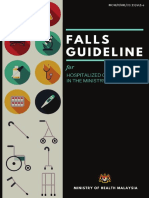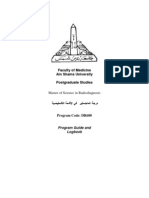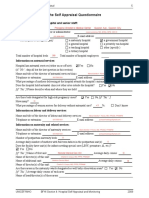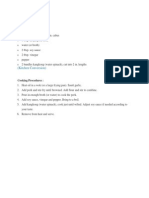Cardiac Radiology
Cardiac Radiology
Uploaded by
tam meiCopyright:
Available Formats
Cardiac Radiology
Cardiac Radiology
Uploaded by
tam meiOriginal Description:
Copyright
Available Formats
Share this document
Did you find this document useful?
Is this content inappropriate?
Copyright:
Available Formats
Cardiac Radiology
Cardiac Radiology
Uploaded by
tam meiCopyright:
Available Formats
CARDIAVASCULAR RADIOLOGY
Part I: Plain Film Anatomy Part II: Plain Film Interpretation Part III: Congenital Heart Disease Part IV: Valvular Heart Disease CHEST RADIOGRAPHS Most commonly requested diagnostic tool in radiology Least costly and frequently effective An essential part of cardiac evaluation Information o Heart size and silhoutte o Enlargement of cardiac chambers o Pulmonary blood flow/ markings The evaluation of the chest film in the cardiac patient involves sequential logical assesment and correlation of both anatomic and physiologic information on the posteroanterior view (PA) and lateral radiographs. PART I: PLAIN FILM ANATOMY Blood Flow: SVC and IVC Right atrium thru Tricuspid valve Right ventricle thru Pulmonic valve Pulmonary arteries LUNGS Pulmonic veins Left atrium thru Mitral valve Left ventricle thru aortic valve aorta Right cardio-mediastinal border SVC Right atrium Right chamber margin IVC Left cardio-mediastinal border Aortic knob Main pulmonary trunk Left atrial appendage Left ventricle Left cardiac border Posterior border on lateral view Left atrium Left ventricle IVC Anterior border on lateral view Right ventricle Posteroanterior (PA) View
Page 1 of 17
Right Border
Page 2 of 17
Lateral View
Page 3 of 17
Lateral View
Lateral View
Page 4 of 17
VISCEROATRIAL SITUS Situs: refers to the pattern of anatomic arrangement Atrial situs is usually concordant with veisceral situs; hence these two are described together Situs Solitus o The morphologic RA is to the RIGHT of the morphologic RA o The gastric air bubble is on the LEFT side and liver is on the RIGHT Situs Inversus o The morphologic RA is to the LEFT of the morphologic LA o The gastric air bubble is on the RIGHT side, and the liver is on the LEFT Situs ambiguous o Used when identification of visceroatrial situs is not possible due to paucity of anatomic markers
PART II: PLAIN FILM INTERPRETATION Systemic Approach 1. Overview or overall glance at the film 2. Check cardiac position and situs 3. Cardiac Size 4. Chamber Enlargement 5. Great Vessels 6. Lungs 7. Ancillary Findings 1. OVERVIEW OR OVERALL GLANCE AT THE FILM Is it adequate or optimal for cardiac evaluation? Things to consider: Position o Slight degrees of rotation or obliquity will substantially affect the cardiac contour and may alter the apparent size as well Inspiration o Should be in full inspiration o In suboptimal inspiration or supine chest radiographs, the lower lobe markings are crowded and may obscure the possibility of early pulmonary edema Exposure o Underexposure may simulate the appearance of pulmonary congestion o Overexposure may simuate diminished pulmonary blood flow CHECK CARDIAC POSITION AND SITUS
Dextrocardia Situs solitus
Dextrocardia Situs inversus
2.
CARDIAC POSITIONS LEVOCARDIA o The heart is predominantly in the LEFT CHEST and the cardiac apex points LEFTWARD DEXTROCARDIA o The heart si predominantly in the RIGHT CHEST, and the cadiac apex points RIGHTWARD MESOCARDIA o The heart is positioned in the MIDLINE and the cardiac apex points directly INFERIORLY DEXTROPOSITION (DEXTROVERSION) o Cardiac apex points LEFTWARD but the heart is located predominantly in the RIGHT CHEST (typically due to extrinsic force)
Situs ambiguous
Page 5 of 17
3.
CARDIAC SIZE
Lateral view: o Retrosternal fullness (contact of anterior cardiac border greater than 1/3 of the sternal length)
CARDIO THORACIC RATIO (CTR) Divide the widest dm of the heart by the widest diameter of the thorax taken at the inner side of the rib cage. Normal CTR: o Adults: 0.5 or < in an adequately taken PE film o Newborn: 0.65 4. CHAMBER ENLARGEMENT
LEFT ATRIAL ENLARGEMENT (LAE) PA view: o Double density o Enlargement of LA appendage o Upliftment of left mainstem bronchus o Widening of carinal angle
RIGHT ATRIAL ENLARGEMENT (RAE) Lateral bulging of the right heart border Elongation of the right heart border (length exceeds 50% of the mediastinal cardiovascular shadow)
RIGHT VENTRICULAR ENLARGEMENT (RVE) PA view: o Rounding and upliftment of cardiac apex
Lateral view: o Prominent posterosuperior cardiac border o Posterior displacement and upliftment of left mainstem bronchus Page 6 of 17
5. LEFT VENTRICULAR ENLARGEMENT (LVE) PA view: o Lateral and downward displacement of the cardiac apex
Great Vessels
PULMONARY VASCULAR PATTERN Normal o Bronchus with bigger dm than artery at suprahilar or perihilar area (if reversed, it is called monocle sign) o Pulmonary blood flow in the normal upright patient is much greater at the bases of the lung than it is at the apex
Lateral view: o Posterior displacement of the posterior inferior border of the heart o Hoffman-Rigler Sign: measured 2 cm above the intersection of the diaphragm and IVC: (+) if posterior border extends more than 1.8 cm of IVC
Page 7 of 17
Decreased o e.g. CHD (TOF), COPD, emphysema
Increased o May be seen in cardiac (left to right shunts such as in ASD, VSD, PDA) and non-cardiac conditions (A-V fistula) o There is increased prominence of both the upper and lower lobes centrally, in the midlung and at the perphery
Page 8 of 17
THE GREAT ARTERIES Are they in normal position? Are they of normal size? Aorta o
Main Pulmonary Artery o Normal
Normal
Prominent
Prominent
Concave
Diminutive 6. 7. Lungs Ancillary Findings
CALCIFICATIONS/ PROSTHESIS Pulmonary artery severe pulmonary arterial HPN Percardial restrictive percarditis Pleural Cardiac valves Coronary artery disease BONE DEFORMITIES Subtle like erosions Retarded overall bonegrowth Widened medullary bone space due to marrow hypertrophy Pectus carinatum which is commonly associated with congenital heart disease Page 9 of 17
PART III: CONGENITAL HEART DISEASES Anatomic malformation of the heart and or its vessels, w/c occurs during the itrauterine development
Incidence: 8/1000 live births Most common congenital malformation 13% will have more than one cardiac defect 25% will have associated non cardiac deformity Etiology: Unknown Multifactorial o Hereditary o Chromosomal abnormality o Maternal infection o Teratogenic drugs o Maternal factors o Environmental
VENTRICIULAR SEPTAL DEFECT (VSD)
RADIOLOGIC INTERPRETATION OF CHD 1. Cyanotic or Non- cyanotic 2. Vascularity 3. Specific chamber enlargement 4. Great Vessels 5. Ancillary Findings
Increased vascularity Normal or enlarged cardiac size Chamber prominence o Either or both ventricles o Left atrium Enlarged main and central pulmonary arteries Normal or small aorta
Page 10 of 17
PATENT DUCTUS ARTERIOSUS (PDA)
ATRIAL SEPTAL DEFECT (ASD)
Increased vascularity Normal or enlarged cardiac size Chamber prominence: o Left ventricle o Left atrium Enlarged main and central pulmonary arteries Prominent aortic knob / dilated aorta
Increased vascularity Cardiomegaly Chamber prominence o Right atrium o Right ventricle Enlarged main and central pulmonary arteries Small aortic knob
TRANSPOSITION OF THE GREAT ARTERIES (D-TGA)
Page 11 of 17
Increased vascularity Cardiomegaly Cardiac silhoutte o Egg on its side o Apple on a stem Narrow vascular pedicle
TOTAL ANOMALOUS OF PULMONARY VENOUS RETURN (TAPVR)
PERSISTENT TRUNCUS ARTERIOSUS (PTA) There is common origin of the pulmonary artery and aorta, a common trunk, the truncus arteriosus
Increased vascularity Pulmonary venous congestion or edema is frequent in Type 1 Cardiomegaly Chamber prominence o Either or both ventricles o Left atrium Concave main pulmonary artery segment (prominent in Type 1) Wide mediastinum due to large aortic shadow Right aortic arch (35%)
Increased vascularity Cardimegaly Chamber prominence: o Right atrium o Right ventricle Enlarged systemic vein into which drainage occurs
TYPE I SUPRACARDIAC Left-sided vertical vein connects pulmonary venous confluence to the LEFT INNOMINATE VEIN, RIGHT SVC OR AZYGOUS VEIN Snowman appearance Page 12 of 17
MIXE TYPE With various connection to the right side of the heart
TYPE II- INTRACARDIAC Connects to the RIGHT ATRIUM OR CORONARY SINUS Radiograph findings: similar to ASD
TETRALOGY OF FALLOT (TOF)
TYPE III- INFRACARDIAC Connection is BELOW THE DIAPHRAGM, TO THE PORTAL VEIN, DUCTUS VENOSUS, OR HEPATIC VEIN Pulmonary edema Normal sized heart Prominence of the RIGT ATRIUM and less often th RIGHT VENTRICLE
Decreased vascularity Normal or enlarged cardiac size Right ventricular prominece Concave main pulmonary artery segment Prominent aorta Right aortic arch in 20-25%
Page 13 of 17
EBSTEINS ANOMALY Tricuspid valve incompetent)
displaced
into
RV
(severely
PULMONARY STENOSIS (PS) Decreased vascularity Marked cardiomegaly Right atrial prominence Balloon or box-shaped
Normal to decreased vascularity Normal or enlarged cardiac size Right ventricular prominence Post stenotic dilatation of the pulmonary artery AORTIC STENOSIS (AS)
Normal vascularity Cardiomegaly Left ventricular prominence Dilated ascending aorta
Page 14 of 17
COARCTATION OF AORTA (COA)
Normal vascularity Cardiomegaly Left ventricular prominence 3 sign Rib notching
PART IV: VALVULAR HEART DISEASE Congenital or acquired Pathophs and CM are similar in both entities Almost all acquired VHD are RHEUMATIC in origin
MITRA STENOSIS (MS)
Normal or slightly enlarged heart Chamber prominence: o Left atrium o Right Ventricle Equalization or cephalization of pulmonary blood flow Prominent main pulmonary artery segment Small aorta
Page 15 of 17
AORTIC STENOSIS (AS)
Normal sized heart or mild cardiomegaly LVH +/- PVH Dilated ascending aorta +/- calcification
MITRAL REGURGITATION (MR)
AORTIC REGURGITATION (AR) Cardiomegaly Chamber prominence: o Left atrium o Left Ventricle Pulmonary venous congestion (MR>MS) Small aorta
Cardiomegaly LVE Dilated ascending aorta and aortic arch Normal pulmonary vascularity Page 16 of 17
Cardiac silhoutte is symmetrically enlarged Lungs are quite clear; normovascular WATERBOTTLE CONFIGURATION
PERICARDIAL EFFUSION BY UTZ
TRICUSPID VALVE DISEASE
Anechoic fluid surrounding the heart 2D echo is the most sensitive method Dampened pulsations
PERCARDIAL EFFUSION IN CT SCAN
Right atrial enlargement +/- SVC or IVC prominence
Thick ring of fluid density around the heart
HEART IN FAILURE Cardiomegaly Increased Pulmonary Vascularity +/- Pleural Effusion
PERCARDIAL EFFUSION ON X-RAY
Dilated Aorta Aortic Stenosis Aortic Insufficiency Systemic HPN
Pulmonary arterial HPN Dilated pulmonary vein and arteries Constriction of peripheral branches
-------------------------------------vvv---------------------------------------Page 17 of 17
You might also like
- Biochemistry Viva QuestionsDocument266 pagesBiochemistry Viva Questionswillson95% (88)
- Symptom Based RadiologyDocument3 pagesSymptom Based Radiologydgina8800No ratings yet
- Vatech EsxDocument51 pagesVatech Esxilietisbitul0% (1)
- SAS™ Kit POGDocument16 pagesSAS™ Kit POGCTOMS Inc.No ratings yet
- Diagnostic Radiology MCQ Sample Exam eDocument7 pagesDiagnostic Radiology MCQ Sample Exam eMuhammad TariqNo ratings yet
- Ma. Elizabeth F. FontanillaDocument48 pagesMa. Elizabeth F. Fontanillatam mei100% (1)
- Falls Guideline - MoH Hospital 2019Document66 pagesFalls Guideline - MoH Hospital 2019Yvonne100% (1)
- OS205 Cardiac ImagingDocument7 pagesOS205 Cardiac ImagingLaurisse ManaloNo ratings yet
- Chest X-ray Interpretation for Radiographers, Nurses and Allied Health ProfessionalsFrom EverandChest X-ray Interpretation for Radiographers, Nurses and Allied Health ProfessionalsNo ratings yet
- Cardiac RadiologyDocument10 pagesCardiac RadiologyHaluk AlibazogluNo ratings yet
- Fundamentals of Chest RadiologyDocument119 pagesFundamentals of Chest RadiologyAlexandra DîrțuNo ratings yet
- @medical - MCQ Chest Radiology MCQsDocument20 pages@medical - MCQ Chest Radiology MCQsKhalid Refaey100% (1)
- Chest Radiology Med Students2Document137 pagesChest Radiology Med Students2Mike Oluwaseun AmooNo ratings yet
- Radiology SpottersDocument24 pagesRadiology SpottersSameer Verma100% (1)
- FRCR Part 1 Anatomy March 2011Document2 pagesFRCR Part 1 Anatomy March 2011drramki27100% (2)
- Cardiac ImagingDocument7 pagesCardiac Imagingsarguss14No ratings yet
- US OB Review (#1 - 61)Document205 pagesUS OB Review (#1 - 61)Júlio Muniz100% (1)
- (RADIO 250) LEC 06 Chest RadiologyDocument10 pages(RADIO 250) LEC 06 Chest Radiologyjmhinos4833No ratings yet
- Bone TumorsDocument58 pagesBone Tumorsdrqazi777No ratings yet
- Interpretation of Chest Imaging1Document91 pagesInterpretation of Chest Imaging1Brooke TurnerNo ratings yet
- Plain Chest X RayDocument154 pagesPlain Chest X RaySamuel Gamadey100% (4)
- Radiology, Radiotherapy Notes To PGDocument16 pagesRadiology, Radiotherapy Notes To PGskycall28No ratings yet
- Master Radiology Notes ChestDocument116 pagesMaster Radiology Notes ChestSnezana Mihajlovic100% (1)
- Master Radiology Notes GITDocument115 pagesMaster Radiology Notes GITuroshkg100% (2)
- Doenças Abdome e PelveDocument262 pagesDoenças Abdome e PelveRicardo CubaNo ratings yet
- FRCR Part 1Document2 pagesFRCR Part 1Mitchel Mary FrancisNo ratings yet
- Radiology Casebook ExamDocument23 pagesRadiology Casebook ExamNiko Montgomery0% (1)
- FRCRDocument7 pagesFRCRtoichongwNo ratings yet
- Osce Radiology 110401045630 Phpapp01Document44 pagesOsce Radiology 110401045630 Phpapp01Wedha Jati Tyas100% (1)
- Clinical Radiology For Surgical Conditions of The AbdomenDocument8 pagesClinical Radiology For Surgical Conditions of The AbdomenPreeti Joan Buxani100% (1)
- Master Radiology Notes GIT PDFDocument115 pagesMaster Radiology Notes GIT PDFuroshkgNo ratings yet
- RADIO 250 (8) LEC 11 Introduction To Interventional RadiologyDocument4 pagesRADIO 250 (8) LEC 11 Introduction To Interventional Radiologyjmhinos4833No ratings yet
- RadiologyDocument29 pagesRadiologyDhon de CastroNo ratings yet
- Anatomy of Chest PDFDocument61 pagesAnatomy of Chest PDFRizwan QureshiNo ratings yet
- Metatarsal Apophysis - Linear and Not FractureDocument14 pagesMetatarsal Apophysis - Linear and Not Fracturenithin shenoiNo ratings yet
- FRCR ChestDocument8 pagesFRCR Chesttoichongw100% (2)
- Toacs 8Document305 pagesToacs 8Mobin Ur Rehman Khan100% (2)
- FRCR Clinical Radiology Lectures: 2 Diagnostic Radiology Fluoroscopy and FluorographyDocument29 pagesFRCR Clinical Radiology Lectures: 2 Diagnostic Radiology Fluoroscopy and FluorographyDr Piyush100% (1)
- Git Radiology and ImagingDocument4 pagesGit Radiology and Imagingoddone_outNo ratings yet
- Doppler Ultrasonography of The Lower Extremity ArteriesDocument34 pagesDoppler Ultrasonography of The Lower Extremity ArteriesNidaa MubarakNo ratings yet
- Radiology Notes For StudentsDocument167 pagesRadiology Notes For Studentsmonika100% (1)
- Radiology PearlsDocument2 pagesRadiology PearlsSalman Rashid100% (2)
- MSK XrayDocument68 pagesMSK Xraydrqazi777No ratings yet
- FRCR US Lecture 1Document76 pagesFRCR US Lecture 1TunnelssNo ratings yet
- FRCR Physics Course 2014 15Document1 pageFRCR Physics Course 2014 15Dr. Shaji teleNo ratings yet
- Neck Swelling MotaweaDocument8 pagesNeck Swelling MotaweaMahmoud MotaweaNo ratings yet
- Rotation in RadiologyDocument6 pagesRotation in Radiologyminci sensei100% (3)
- Emergency Radiology MAHMUOD PDFDocument134 pagesEmergency Radiology MAHMUOD PDFCut Nonda MaraciluNo ratings yet
- Chest X-Ray IntDocument355 pagesChest X-Ray Intpk.bhayanaNo ratings yet
- FRCR 2a March 2010 PapersDocument12 pagesFRCR 2a March 2010 PapersAjay Agarwal100% (2)
- Medical InvestigationsDocument7 pagesMedical InvestigationsmedpgnotesNo ratings yet
- DNB Radiology PapersDocument55 pagesDNB Radiology PaperskhanaknandoliaNo ratings yet
- Chest Part 4Document19 pagesChest Part 4rakshit09No ratings yet
- Introduction For New Registrars In: Clinical RadiologyDocument14 pagesIntroduction For New Registrars In: Clinical Radiologyamina tighiltNo ratings yet
- Radiology Notes - UltrasoundDocument15 pagesRadiology Notes - UltrasoundborstNo ratings yet
- Radiology MCQsDocument4 pagesRadiology MCQsZafar Khan60% (5)
- Radiod MasterDocument149 pagesRadiod MasterAhmeid Eid0% (1)
- Radiology Morning 5 TH Sep 2018Document10 pagesRadiology Morning 5 TH Sep 2018Arshad AliNo ratings yet
- Interpretation of Chest RadiographsDocument37 pagesInterpretation of Chest RadiographsAnshul JainNo ratings yet
- Chest X RaysDocument31 pagesChest X RaysEmma CatterallNo ratings yet
- A Teaching Atlas of Case Studies in Diagnostic ImagingDocument465 pagesA Teaching Atlas of Case Studies in Diagnostic Imagingrodrigue t100% (1)
- The Ultimate Guide to Vascular Ultrasound: Diagnosing and Understanding Vascular ConditionsFrom EverandThe Ultimate Guide to Vascular Ultrasound: Diagnosing and Understanding Vascular ConditionsNo ratings yet
- Psa Recommendations FOR Standard Practice For AnesthesiologistsDocument10 pagesPsa Recommendations FOR Standard Practice For Anesthesiologiststam meiNo ratings yet
- Transverse Myelitis Preexisting in Pregnancy A Case ReportDocument6 pagesTransverse Myelitis Preexisting in Pregnancy A Case Reporttam meiNo ratings yet
- SPG 16 10460Document13 pagesSPG 16 10460tam meiNo ratings yet
- Psa Isura 2019Document11 pagesPsa Isura 2019tam meiNo ratings yet
- Aendicus 3 UpdateDocument13 pagesAendicus 3 Updatetam meiNo ratings yet
- MBFH Self Assessment TestDocument20 pagesMBFH Self Assessment Testtam meiNo ratings yet
- Drug Index Updated2Document113 pagesDrug Index Updated2tam meiNo ratings yet
- Biochem Post TestDocument9 pagesBiochem Post Testtam meiNo ratings yet
- Pelvic Inflamatory DiseaseDocument8 pagesPelvic Inflamatory Diseasetam mei100% (1)
- Aherrera NotesDocument213 pagesAherrera NotesVerna Santiago71% (7)
- Cadiovascular DiseasesDocument12 pagesCadiovascular Diseasestam meiNo ratings yet
- Cityassessor Sworn Statement PDFDocument1 pageCityassessor Sworn Statement PDFtam mei0% (1)
- Nephrotic and NephriticDocument27 pagesNephrotic and Nephritictam meiNo ratings yet
- Jurnal HegDocument7 pagesJurnal HegAmanda Mahendra SastranegaraNo ratings yet
- Guinataang Mais (Corn in Coconut Milk) : (Conversions For Cooking)Document1 pageGuinataang Mais (Corn in Coconut Milk) : (Conversions For Cooking)tam meiNo ratings yet
- Sworn Declaration of No Improvement On Real Property: (Date of Sale/donation/death of Decedent)Document1 pageSworn Declaration of No Improvement On Real Property: (Date of Sale/donation/death of Decedent)tam meiNo ratings yet
- Filipino Bread PuddingDocument1 pageFilipino Bread Puddingtam meiNo ratings yet
- Breech DeliveryDocument35 pagesBreech Deliverytam mei100% (2)
- (Kitchen Conversion) : IngredientsDocument1 page(Kitchen Conversion) : Ingredientstam meiNo ratings yet
- (Cooking Measurements) : IngredientsDocument1 page(Cooking Measurements) : Ingredientstam meiNo ratings yet
- Champorado: (Measurements Cooking)Document1 pageChamporado: (Measurements Cooking)tam meiNo ratings yet
- Fontanilla, Crista Mae F.: ObjectiveDocument2 pagesFontanilla, Crista Mae F.: Objectivetam meiNo ratings yet
- Resume - Seyed Alaedin FerdousiDocument3 pagesResume - Seyed Alaedin Ferdousimohammadrezahajian12191No ratings yet
- Pemphigus VulgarisDocument21 pagesPemphigus VulgarisGina Kissey100% (1)
- Patient Safety Systems (PS) : Source: Committee To Design A Strategy For Quality Review and Assurance inDocument54 pagesPatient Safety Systems (PS) : Source: Committee To Design A Strategy For Quality Review and Assurance inBahtiar AfandiNo ratings yet
- Documentation in NursingDocument43 pagesDocumentation in NursingMAHMOOD AHMED100% (19)
- Conceptual Model, Theories and ResearchDocument15 pagesConceptual Model, Theories and Researcheelyenoh18No ratings yet
- Paplau, AbdellahDocument41 pagesPaplau, AbdellahJ Ta RaNo ratings yet
- 101 Newsletter Topic IdeasDocument2 pages101 Newsletter Topic IdeasAlexandra NinaNo ratings yet
- Community-Based Health Insurance in Developing CountriesDocument14 pagesCommunity-Based Health Insurance in Developing CountriesRakip MaloskiNo ratings yet
- 43 Questions NLE Dec 2011Document15 pages43 Questions NLE Dec 2011Lyka Cuanan CorcueraNo ratings yet
- Roleplay Pemeriksaan TTVDocument5 pagesRoleplay Pemeriksaan TTVNona Neldin LesielaNo ratings yet
- DR BanshaliDocument2 pagesDR BanshaliIshsatNo ratings yet
- West Visayas State University: Nursing ProcessDocument4 pagesWest Visayas State University: Nursing ProcessPhylum Chordata100% (1)
- FDA Medical Device LabelingDocument54 pagesFDA Medical Device LabelingYachao LiuNo ratings yet
- CementumDocument10 pagesCementumAshish BisaneNo ratings yet
- Age Changes in Oral TissueDocument34 pagesAge Changes in Oral TissueAiswarya MishraNo ratings yet
- 5 Plantarfasciitis Exercises1Document2 pages5 Plantarfasciitis Exercises1Fahmi Nur SuwandiNo ratings yet
- Riya Parikh Essay 4 1Document6 pagesRiya Parikh Essay 4 1api-3026862950% (1)
- Otitis Media - CSDocument14 pagesOtitis Media - CSMASII100% (3)
- E.R. Nurses - James PattersonDocument338 pagesE.R. Nurses - James Pattersonhuangshibo1982No ratings yet
- Anosh Albert FileDocument4 pagesAnosh Albert FileKeep smileNo ratings yet
- Oral CandidiasisDocument22 pagesOral CandidiasisSherlocknovNo ratings yet
- LQMS 5-4 Sample ProcessingDocument2 pagesLQMS 5-4 Sample ProcessingfatmeNo ratings yet
- Dentistry CourseDocument71 pagesDentistry CourseeduardoNo ratings yet
- HYGIENEDocument69 pagesHYGIENERhea Jane Dela Cruz100% (1)
- Emotional Intelligence Assigment Bs 111Document8 pagesEmotional Intelligence Assigment Bs 111amier_sNo ratings yet
- Psych 7A FinalDocument16 pagesPsych 7A FinalMatthew Kim100% (1)
- Fluphenazine Decanoate RBMDocument9 pagesFluphenazine Decanoate RBMMustika OktariniNo ratings yet

















































































































